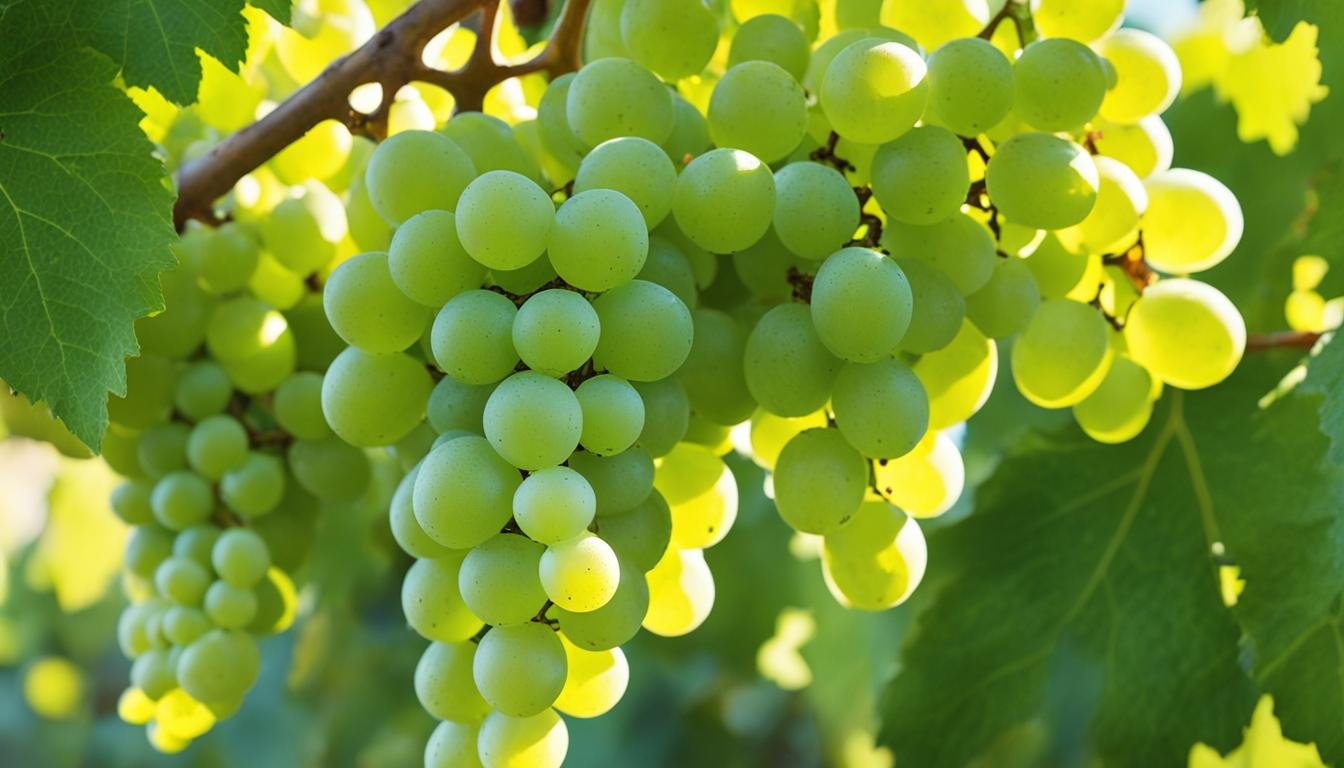This post may contain affiliate links. Please read my disclosure policy.
Albariño: The Vibrant Virtuoso of Spanish Whites
Introduction
Albariño, pronounced “Al-ba-ree-nyo,” is the star performer of the Spanish white wine world, dazzling with its lively character and aromatic flair. This grape variety, hailing from the cool, misty region of Rías Baixas in Galicia, Spain, is celebrated for its zesty acidity and vibrant flavours. Let’s dive into the world of Albariño – a wine that brings the refreshing essence of Spain’s Atlantic coast to the glass.
Primary Flavours
Sampling Albariño is akin to a sensory fiesta. It bursts with fresh notes of peach, apricot, and citrus, accompanied by delicate floral undertones and a hint of saline minerality. There’s an exuberance to Albariño, a lively freshness that evokes images of seaside terraces and sunlit orchards.
Taste Profile
| Albariño | Albariño | Albariño |
|---|---|---|
| Aspect | Rating out of 5 | Characteristic |
| Sweetness | 🍷 | Predominantly dry, with a hint of seaside zest |
| Body | 🍷🍷🍷 | Medium-bodied, as refreshing as a breeze off the Galician coast |
| Tannins | Nearly absent, as smooth as a calm sea | |
| Acidity | 🍷🍷🍷🍷 | Bright and lively, like a lively fiesta |
| Alcohol by Volume | 🍷🍷🍷 | Typically around 12-13%, as welcoming as Spanish hospitality |
| Each wine glass icon 🍷 represents one point on a 5-point scale. Albariño is renowned for its crisp acidity and vibrant, fresh flavours, often featuring notes of citrus, green apple, and stone fruits, sometimes with a mineral edge. It's a delightful wine, particularly famous in the Rías Baixas region, and pairs wonderfully with seafood. | Each wine glass icon 🍷 represents one point on a 5-point scale. Albariño is renowned for its crisp acidity and vibrant, fresh flavours, often featuring notes of citrus, green apple, and stone fruits, sometimes with a mineral edge. It's a delightful wine, particularly famous in the Rías Baixas region, and pairs wonderfully with seafood. | Each wine glass icon 🍷 represents one point on a 5-point scale. Albariño is renowned for its crisp acidity and vibrant, fresh flavours, often featuring notes of citrus, green apple, and stone fruits, sometimes with a mineral edge. It's a delightful wine, particularly famous in the Rías Baixas region, and pairs wonderfully with seafood. |
Growing Regions
Albariño is synonymous with Rías Baixas, where the cool, rainy climate and granitic soils create the ideal conditions for this grape to thrive. Its popularity has grown beyond the Spanish borders, with plantings in Portugal (where it’s known as Alvarinho), the United States, and Australia, each region adding its unique twist to the Albariño story.
Origin and Winemaking
Albariño’s origins are as intriguing as its taste, with a history that intertwines with the maritime heritage of Galicia. Traditionally, Albariño grapes were grown on high trellises to protect them from moisture. Modern viticulture and winemaking techniques have elevated Albariño’s profile, showcasing its potential to produce wines that are both complex and approachable.
Serving Temperature
The ideal serving temperature for Albariño is around 8-10°C (46-50°F). Chilled but not overly so, this temperature range allows the wine’s vibrant fruit flavours and floral aromas to shine, while maintaining its characteristic acidity and freshness.
Serving Albariño too cold can mute its aromatic complexity, whereas too warm a temperature may diminish its refreshing qualities. At this optimal temperature, Albariño is like a lively melody that dances on the palate, bringing a burst of coastal freshness to every sip.
Glassware
The choice of glassware is key in fully appreciating Albariño’s aromatic charm. A white wine glass with a moderate bowl is ideal, as it concentrates the wine’s fragrant bouquet, enhancing the delicate floral and fruity notes.
The glass should also allow some space for swirling, releasing the wine’s array of scents and facilitating a more complete sensory experience. In the right glass, Albariño’s aromatic profile is beautifully showcased, akin to a bright, harmonious chord that resonates with every sniff and sip.
Decanting
Decanting is not typically necessary for Albariño. This wine is celebrated for its fresh, vibrant character, best enjoyed in its youth. Decanting might not significantly enhance Albariño’s profile, as it’s a wine that delights with its immediacy and zesty appeal.
Straight from the bottle, Albariño is ready to captivate, offering a crisp, refreshing experience that epitomizes the spirit of Galicia’s verdant, coastal landscapes.
Ageing
Albariño is generally best enjoyed within a few years of its vintage, capturing the essence of its youthful vivacity and crisp, fruity profile. While some high-quality Albariños can develop additional complexity with a few years of bottle ageing, the wine’s primary allure is its immediacy and bright, fresh flavours. Ageing Albariño for too long may result in a loss of the lively, zesty characteristics that define its charm.
Food Pairings
Albariño is a superb companion to a myriad of culinary delights, particularly seafood. Its crisp acidity and citrusy notes make it a perfect pairing for shellfish, grilled fish, and sushi. The wine’s refreshing quality also complements light salads, soft cheeses, and a variety of appetizers. Its versatility at the table mirrors the diverse culinary traditions of Galicia, making Albariño a go-to choice for food-friendly pairings.
Wine Labels
Exploring the various expressions of Albariño through different labels is a delightful way to experience its range. Below is a table showcasing popular brands, each representing a unique interpretation of this vibrant grape:
| Albariño | Albariño | Albariño |
|---|---|---|
| Country | Wine Label | Varietal Name & Style |
| Spain | Martin Codax | Rías Baixas Albariño - Crisp, Aromatic |
| Spain | Pazo de Señorans | Rías Baixas Albariño - Elegant, Complex |
| USA | Abacela | Oregon Albariño - Bright, Fruit-Forward |
| Australia | Art Wine | The Real Thing Albariño - Zesty, Refreshing |
| Portugal | Quinta de Santiago | Vinho Verde Alvarinho - Light, Mineral |
| Note: These brands showcase Albariño’s versatility, from the classic Rías Baixas style to new world interpretations, reflecting the adaptability and global appeal of this Spanish gem. | Note: These brands showcase Albariño’s versatility, from the classic Rías Baixas style to new world interpretations, reflecting the adaptability and global appeal of this Spanish gem. | Note: These brands showcase Albariño’s versatility, from the classic Rías Baixas style to new world interpretations, reflecting the adaptability and global appeal of this Spanish gem. |
Conclusion
Albariño is more than just a wine; it’s a mood. It’s the embodiment of summer – bright, effervescent, and always ready to bring a little lightness to your palate. So next time you’re yearning for a taste of sunshine and seaside charm, pop open a bottle of Albariño. It’s like a mini-holiday in a glass.
Is Albariño a red or white wine?
Albariño is a white wine grape, known for making aromatic, crisp white wines.
Where does the name Albariño originate from?
The name “Albariño” is Galician, reflecting the grape’s strong ties to the Galicia region in northwest Spain. It’s thought to derive from the word ‘albar’, meaning ‘white’ or ‘bright’ in the local language.
What are some interesting facts about Albariño?
• Albariño is a high-quality white grape variety from Spain, particularly from the Rías Baixas region in Galicia.
• Renowned for its aromatic profile, often featuring floral and stone fruit scents.
• Produces light to medium-bodied wines with high acidity.
• Common flavours include peach, apricot, melon, and citrus, often with a mineral edge.
Is Albariño known by any other names?
Albariño is generally known by this name in Spain and internationally. In Portugal, it’s known as Alvarinho and is used in Vinho Verde. The names reflect regional language differences but refer to the same grape variety.
User Review
( votes)Sip smarter, subscribe now!
Subscribe for gourmet tips, event updates, travel ideas, and a free e-book on Food Pairings. Start your journey to culinary and travel excellence!













